Aidas Mammoth Gold Phono Cartridge
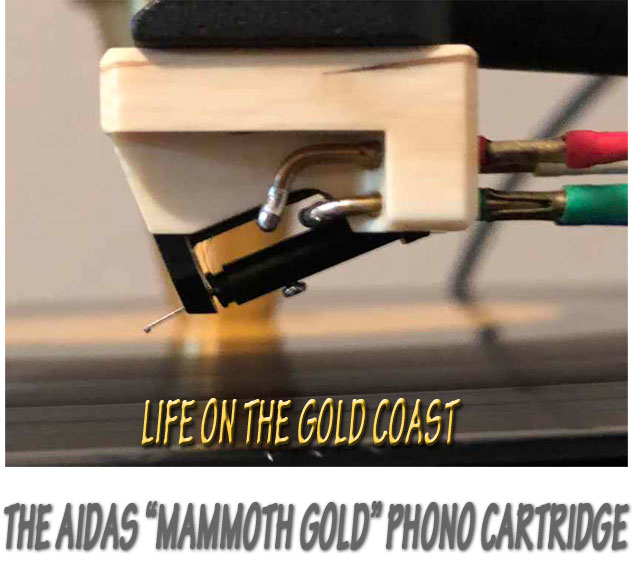
 Chicago is a city known for its many diverse neighborhoods. This is a city that at one time, its most popular neighborhood was called “Jew Town.” It was a neighborhood that had been home to a large population of Jewish immigrants and on weekends transformed into one of the country’s most famous open-air markets. At the heart of the neighborhood was the corner of Maxwell Street and Halsted. The place was always teeming with locals and tourists alike who had come to buy and sell everything from fur coats to 8-track tapes. It was also famous for the legendary bluesmen who setup an amp and mic on almost every street corner and played glorious music from dawn ‘til dusk. People like Muddy Waters, Bo Diddley and Howlin’ Wolf, have all been part of this neighborhood’s fabric. Then you have Wrigleyville, home of the Chicago Cubs and one of the most iconic baseball stadiums in the world, Wrigley Field. Wrigleyville is characterized by young urban professionals (yuppies) and despite having more bars per-capita than any other neighborhood in the state, has become one of the most family friendly neighborhoods in the city. Hmm, one might surmise that the activity in all those bars led to the creation of all those families. Englewood, the neighborhood that was the basis for the controversial Spike Lee film, “Chiraq,” is known as being one of the most dangerous neighborhoods in the country. Despite at one time being considered a lower-middle class neighborhood, it is now characterized by rampant crime and poverty despite also being the neighborhood that produced NBA superstars Derrick Rose and Anthony Davis, and music superstars Jennifer Hudson and Mavis Staples. And then, at the other end of the socioeconomic scale, there’s the Gold Coast. If you hadn’t figured it out by the name, this is the neighborhood for the wealthy and powerful. The Gold Coast is characterized by generational wealth, political power and high-end… everything. The Gold Coast is what people mean when they talk about how, “the other half lives.”
Chicago is a city known for its many diverse neighborhoods. This is a city that at one time, its most popular neighborhood was called “Jew Town.” It was a neighborhood that had been home to a large population of Jewish immigrants and on weekends transformed into one of the country’s most famous open-air markets. At the heart of the neighborhood was the corner of Maxwell Street and Halsted. The place was always teeming with locals and tourists alike who had come to buy and sell everything from fur coats to 8-track tapes. It was also famous for the legendary bluesmen who setup an amp and mic on almost every street corner and played glorious music from dawn ‘til dusk. People like Muddy Waters, Bo Diddley and Howlin’ Wolf, have all been part of this neighborhood’s fabric. Then you have Wrigleyville, home of the Chicago Cubs and one of the most iconic baseball stadiums in the world, Wrigley Field. Wrigleyville is characterized by young urban professionals (yuppies) and despite having more bars per-capita than any other neighborhood in the state, has become one of the most family friendly neighborhoods in the city. Hmm, one might surmise that the activity in all those bars led to the creation of all those families. Englewood, the neighborhood that was the basis for the controversial Spike Lee film, “Chiraq,” is known as being one of the most dangerous neighborhoods in the country. Despite at one time being considered a lower-middle class neighborhood, it is now characterized by rampant crime and poverty despite also being the neighborhood that produced NBA superstars Derrick Rose and Anthony Davis, and music superstars Jennifer Hudson and Mavis Staples. And then, at the other end of the socioeconomic scale, there’s the Gold Coast. If you hadn’t figured it out by the name, this is the neighborhood for the wealthy and powerful. The Gold Coast is characterized by generational wealth, political power and high-end… everything. The Gold Coast is what people mean when they talk about how, “the other half lives.”

I thought about this “other half” analogy when Victor Simakov, owner of ViRa USA, distributor of the Aidas phono cartridges, sent me the $8,000 Mammoth Gold phono cartridge to review. If the $3,000 Aidas Black Sound-Red Heart cartridge that I reviewed back in July was the cartridge designed for the masses, then the Mammoth Gold had to be designed for… “the other half.” When the Black Sound-Red Heart arrived, it came in a small cardboard shipping box. Nothing special. Inside the box, was a nicely made little wood box with the Aidas logo on it. In side the wood box was the cartridge and a small piece of paper with the cartridge’s specs.
The Mammoth Gold however, is from a whole different neighborhood. To begin with, I was surprised at how big a box the Mammoth Gold came in. At first, I thought that maybe it came with a moving coil step-up transformer because when I open the shipping box, I saw a big, black case, similar to the ones that power drills come in. But when I opened that case, what I saw really took me by surprise. Inside the case was grey packing foam with two cutouts. The first cutout was for a small, lovely jewel box. According to ViRa USA this box is made of Siberian semi-precious stone. Inside was a small, polished metal plate with the ViRa logo on it and just below it sat the Mammoth Gold cartridge. But that wasn’t all. In the other cutout was a 50cL bottle of Mamont Siberian Vodka. If you’re not familiar with this brand of vodka, well join the club because neither am I. But being a neophyte vodka drinker, I was more taken with the bottle which is designed to resemble a mammoth’s tusk. I immediately took the bottle out and placed it on my dinning room table. I didn’t open it right away, I just thought it was cool looking. Also attached inside the case was a gold colored plaque with the cartridge’s specs on it.

The Mammoth Gold Cartridge
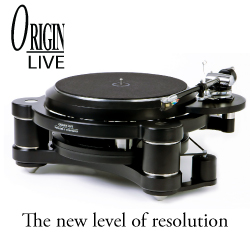 The Aidas Mammoth Gold is the newest and the most advanced of the Aidas cartridges. The cartridge’s body is made with the ivory from 23,000 year old Siberian wooly mammoth tusks. The properties of this ivory are said to be closest to that of human bones and have similar resonance characteristics. Resonance control is a major variable in analogue system design and setup. Now this may sound creepy but bear in mind that the human bones that this material is most like are the Auditory Ossicle bones that are located in the middle ear. Make of that what you will, but it kind of makes sense. (Ed. Note: According to the website digitaljournal.com, mammoth tusk ivory is not currently protected under the Convention on International Trade in Endangered Species treaty.)
The Aidas Mammoth Gold is the newest and the most advanced of the Aidas cartridges. The cartridge’s body is made with the ivory from 23,000 year old Siberian wooly mammoth tusks. The properties of this ivory are said to be closest to that of human bones and have similar resonance characteristics. Resonance control is a major variable in analogue system design and setup. Now this may sound creepy but bear in mind that the human bones that this material is most like are the Auditory Ossicle bones that are located in the middle ear. Make of that what you will, but it kind of makes sense. (Ed. Note: According to the website digitaljournal.com, mammoth tusk ivory is not currently protected under the Convention on International Trade in Endangered Species treaty.)
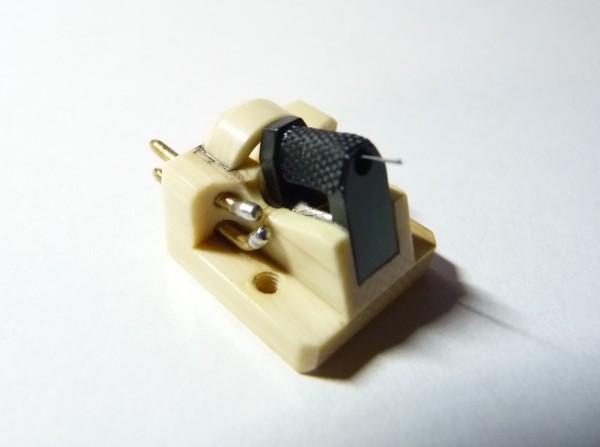
The Mammoth Gold is a low-output moving coil cartridge that uses a Namiki Micro Ridge stylus and a Namiki/Adamant boron composite cantilever. The 0.03mm copper wires are slightly more refined than those used on the Black Sound-Red Heart. It connects the coils coming from the cantilever run through nicely soldered brass conduits, which connect to the output pins. According to Simakov: “The generator and driver parts are made of titanium, wolfram, gold, silver, copper and a specially formulated damping compound. More than 200 different compound types were tested just to tune the cartridge. Specially designed damping systems have two unique tiers of compound around the generator and tension cord, along with cantilever damping pack. One part of the damper is just few microns thick and is a piece of art on it’s own. The price of this cartridge reflects not just the type of component materials being used, but the production time that is five times more than other Aidas cartridges. The fine tuning of Mammoth Gold takes nearly 15 hours after final assembly is done.”
Like I said of the Black Sound-Red Heart, these cartridges are sleek yet robust looking and are as well-built an open-bodied cartridge as I have ever seen. But because of the use of exotic materials, the Mammoth Gold increases the “high-end factor” by a multiple of ten. Thankfully, this new cartridge is only about 2 ½ times the price of its more affordable sibbling. But does that make it a better bargain, or a bargain at all? Read on.
System Setup
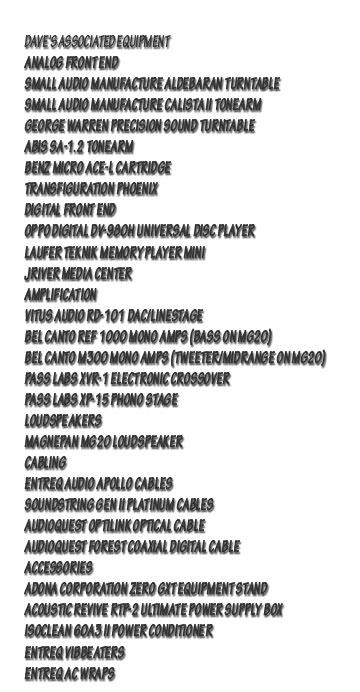 In reading this review, I think you should consider all of the different analogue components that have been a part of my reference system over the last year or so. This time, last year, my analogue rig consisted of my longtime favorite, George Warren Precision Sound turntable, Abis SA-1.2 tonearm and Benz Micro Ace-L cartridge. But while writing the review of the Black Sound-Red Heart, I made some significant additions to my analogue source. First, I added the excellent and waaay too affordable for its on good, Small Audio Manufacture (S.A.M.) Aldebaran turntable. Initially the table was outfitted with the brilliant Abis tonearm and I borrowed my brother’s Transfiguration Phoenix cartridge. A few months later, Clement Perry sent me his S.A.M. Calista II tonearm and I was so taken by what a synergistic match it was with the table, that I ordered a brand new Calista II. For me, this Croation table and arm set a new standard for quality and value. All configurations fed a signal to the excellent Pass Labs XP-15 phonostage.
In reading this review, I think you should consider all of the different analogue components that have been a part of my reference system over the last year or so. This time, last year, my analogue rig consisted of my longtime favorite, George Warren Precision Sound turntable, Abis SA-1.2 tonearm and Benz Micro Ace-L cartridge. But while writing the review of the Black Sound-Red Heart, I made some significant additions to my analogue source. First, I added the excellent and waaay too affordable for its on good, Small Audio Manufacture (S.A.M.) Aldebaran turntable. Initially the table was outfitted with the brilliant Abis tonearm and I borrowed my brother’s Transfiguration Phoenix cartridge. A few months later, Clement Perry sent me his S.A.M. Calista II tonearm and I was so taken by what a synergistic match it was with the table, that I ordered a brand new Calista II. For me, this Croation table and arm set a new standard for quality and value. All configurations fed a signal to the excellent Pass Labs XP-15 phonostage.
My digital front-end consists of the Laufer Teknik Memory Player Mini and a OPPO DV980H Universal Disc Player. Both units, along with the XP-15 feed a Vitus Audio RD-101 DAC/linestage. My reference system is still anchored by my Maggie MG20s being driven by two pairs of Bel Canto mono amps (M300s for the tweeter/midrange. REF1000Ms for the bass). This configuration is controlled by the Pass Labs XVR-1 electronic crossover. Most of the cabling is the Soundstring GEN II Platinum except for the AudioQuest Forest digital cables.
A Shot and a Gold!
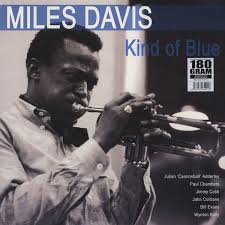 I decided to start my serious listening after (a few shots of Mamont Vodka) and the same album I listened to when I started evaluating the Black Sound-Red Heart, the 180 gm pressing of Miles Davis’ Kind of Blue [Columbia]. I started by listening to the second track, “Freddie Freeloader.” Now I have listened to this album for years and have always enjoyed this tune. But this was the first time that I listened to it and found myself being mesmerized by someone other than Miles. The solo performances by pianist, Wynton Kelly and John Coltrane on tenor sax are nothing short of spectacular. The Mammoth Gold is a wonderful groove tracker. So much so that it retrieved intricate details from this recording that reminded me of why I love vinyl so much. The sense of realism that the Mammoth Gold renders these solos with, reminds me of the joy I get from listening to old Quads. There is wonderful image specificity of the instruments on this recording, and this cartridge seems to breathe new life into these tunes.
I decided to start my serious listening after (a few shots of Mamont Vodka) and the same album I listened to when I started evaluating the Black Sound-Red Heart, the 180 gm pressing of Miles Davis’ Kind of Blue [Columbia]. I started by listening to the second track, “Freddie Freeloader.” Now I have listened to this album for years and have always enjoyed this tune. But this was the first time that I listened to it and found myself being mesmerized by someone other than Miles. The solo performances by pianist, Wynton Kelly and John Coltrane on tenor sax are nothing short of spectacular. The Mammoth Gold is a wonderful groove tracker. So much so that it retrieved intricate details from this recording that reminded me of why I love vinyl so much. The sense of realism that the Mammoth Gold renders these solos with, reminds me of the joy I get from listening to old Quads. There is wonderful image specificity of the instruments on this recording, and this cartridge seems to breathe new life into these tunes.
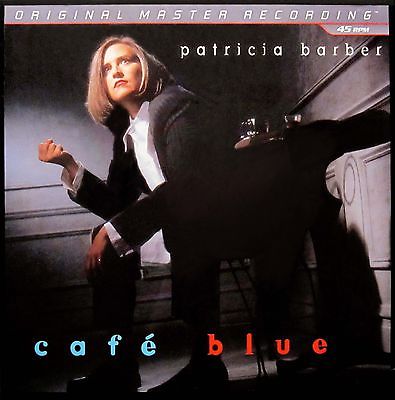 The next recording was the Mobile Fidelity 45RPM version of Patricia Barber’s classic, Café Blue [MFSL 3-45002]. This was the quintessential jazz album for demos at countless audio shows, back in the day. The opening track, “What a Shame” dominated listening rooms with Barber’s signature smokey vocals and sultry piano playing. It dominated my listening room too, during this review. In fact the whole album did. But the track that got the most play was “Nardis.” Those of you who are familiar with this track, know that it features a fantastic percussion solo by Mark Walker. The Mammoth Gold draws so much music out of the grooves that the dynamics from the percussion solo can be downright violent (but in a good way). I found myself wincing on more than one occasion at the pops of the snare drums. This ability to retrieve fine detail also translates into an ability to relay deep bass so that it sounds like bass coming from a musical instrument and not just bloated bass energy. The ability to follow bassist Mike Arnopol’s performance on this track is evidence of this. This is a cartridge that will not let you feel cheated if you’re one of those people who spends the cash for ultra-high quality recordings. See, this all feeds into the whole Gold Coast thing. More money gets you more.
The next recording was the Mobile Fidelity 45RPM version of Patricia Barber’s classic, Café Blue [MFSL 3-45002]. This was the quintessential jazz album for demos at countless audio shows, back in the day. The opening track, “What a Shame” dominated listening rooms with Barber’s signature smokey vocals and sultry piano playing. It dominated my listening room too, during this review. In fact the whole album did. But the track that got the most play was “Nardis.” Those of you who are familiar with this track, know that it features a fantastic percussion solo by Mark Walker. The Mammoth Gold draws so much music out of the grooves that the dynamics from the percussion solo can be downright violent (but in a good way). I found myself wincing on more than one occasion at the pops of the snare drums. This ability to retrieve fine detail also translates into an ability to relay deep bass so that it sounds like bass coming from a musical instrument and not just bloated bass energy. The ability to follow bassist Mike Arnopol’s performance on this track is evidence of this. This is a cartridge that will not let you feel cheated if you’re one of those people who spends the cash for ultra-high quality recordings. See, this all feeds into the whole Gold Coast thing. More money gets you more.
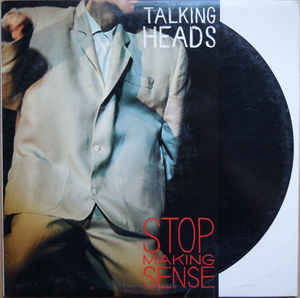 Moving on to some live music, the Mammoth Gold really shined when it was put to the test on the great Talking Heads’ live performance of “Psycho Killer”, from Stop Making Sense [Sire Records]. This track is a blast to listen to as David Byrne comes out on stage, sets a boombox down that plays a drum beat while Byrne, himself plays an acoustic guitar. Now you may be thinking, “Dave, how musical can a song with a boombox playing the drum track be?” Silly mortals. There is more to this song than just the music. The sense of the performance space, the audience interaction, the purity of the acoustic guitar, Byrne’s obscure vocal stylings, are all part of the splendor of this performance. Not all audiophile recordings are characterized by “holographic imaging” and “bass of subterrainian depth.” Sometimes it’s just a dorky guy in a big, white linen suit. But my favorite tune from this album is “Burning Down The House.” I make no bones about my adoration for all things P-Funk and when you listen to this song you are hearing a brilliant performance by one of Parliament-Funkadelic’s most prominent members, child prodigy Bernie “Dr. Funkenstein” Worrell. Worrell gets more funk out of his synthesizer than is humanly possible. What the Mammoth Gold does with this song is it faithfully replicates the positioning of the performers within the soundstage. How do I know? Well, for one, I saw the concert film and the internet is loaded with photos and videos that also show where the performers are on stage. Genius. Besides, you won’t be thinking about that while Bernie is going off on some musical tangent. It’s truly a treat for the ears.
Moving on to some live music, the Mammoth Gold really shined when it was put to the test on the great Talking Heads’ live performance of “Psycho Killer”, from Stop Making Sense [Sire Records]. This track is a blast to listen to as David Byrne comes out on stage, sets a boombox down that plays a drum beat while Byrne, himself plays an acoustic guitar. Now you may be thinking, “Dave, how musical can a song with a boombox playing the drum track be?” Silly mortals. There is more to this song than just the music. The sense of the performance space, the audience interaction, the purity of the acoustic guitar, Byrne’s obscure vocal stylings, are all part of the splendor of this performance. Not all audiophile recordings are characterized by “holographic imaging” and “bass of subterrainian depth.” Sometimes it’s just a dorky guy in a big, white linen suit. But my favorite tune from this album is “Burning Down The House.” I make no bones about my adoration for all things P-Funk and when you listen to this song you are hearing a brilliant performance by one of Parliament-Funkadelic’s most prominent members, child prodigy Bernie “Dr. Funkenstein” Worrell. Worrell gets more funk out of his synthesizer than is humanly possible. What the Mammoth Gold does with this song is it faithfully replicates the positioning of the performers within the soundstage. How do I know? Well, for one, I saw the concert film and the internet is loaded with photos and videos that also show where the performers are on stage. Genius. Besides, you won’t be thinking about that while Bernie is going off on some musical tangent. It’s truly a treat for the ears.
Conclusion
There was a brief time when I had both Aidas cartridges in house, so I decided to do a quick comparison. I kept in mind that while the Black Sound-Red Heart was good and broken in, the Mammoth Gold was new. I also had to consider that the new cartridge was far more expensive.
With those caveats, what I found was that both cartridges were well-built, excellent trackers that render music wonderfully. The main difference is that the Mammoth Gold, with its unique body material and refined design and use of higher quality materials, simply allows it to deliver a little bit more of… well, everything. More musical detail, a sharper rendering of instruments and a decidedly more spacious and realistic soundstage. But this is not to say that the level of performance of the less expensive cartridge was not satisfying, it is. In fact, I was very close to purchasing that cartridge because of its performance… and the fact that I could afford it. Who knows, I still might. It’s that good. But back to my Gold Coast analogy. Right now, I’m probably more of a Wrigleyville kind of guy, but if I could afford the Mammoth Gold, I would be moving into that neighborhood. I can’t recommend it highly enough.


dave thomas
Specifications:
Body: 23,000 years old Mammoth ivory task
Cantilever: Namiki / Adamant boron composite
Stylus:”Namiki” MicroRidge
Output: 0.28mV
Magnet system: AlNiCo5
Tracking force: 1.6-1.8g.
Compliance lateral: 12 um/mN
Cartridge weight: 10.1-10.1g.
Recommended loading: 4 ohms
Channel separation: >30dB/1kHz
Channel balance: >1dB/1kHz
Coils: copper 0.03mm
Mount: thread M2.5×0.45, 1/2 inch / 12.7mm standard between the holes
Trackability at 300Hz/1.6g: 70-80uM
Vertical tracking angle: 20 degrees
Recommended tonearm mass: medium
Damping system: 2X
Break-in period: 50 hours
Price: $8,000.00
Contact:
ViRa High End
206 Spruce St.
Tehachapi, CA 93561
USA
Tel: +1 (310) 806 2854
Email us: virausa@yahoo.com
Stereo Times Masthead
Publisher/Founder
Clement Perry
Editor
Dave Thomas
Senior Editors
Frank Alles, Mike Girardi, Russell Lichter, Terry London, Moreno Mitchell, Paul Szabady, Bill Wells, Mike Wright, and Stephen Yan,
Current Contributors
David Abramson, Tim Barrall, Dave Allison, Ron Cook, Lewis Dardick, John Hoffman, Dan Secula, Don Shaulis, Greg Simmons, Eric Teh, Greg Voth, Richard Willie, Ed Van Winkle, Rob Dockery, Richard Doron, and Daveed Turek
Site Management Clement Perry
Ad Designer: Martin Perry





Be the first to comment on: Aidas Mammoth Gold Phono Cartridge